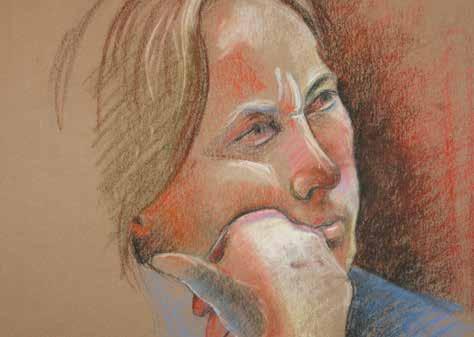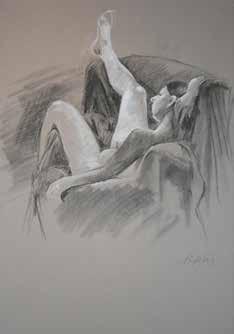
4 minute read
Phyllis Shafer
SUBMIT YOUR EVENTS FOR FREE
Visit TheTahoeWeekly.com to add your Event for our print & online calendars.
Advertisement
Click on Events; then the blue Add Event button.
ART LEAGUE HOSTS LOGO CONTEST
Tahoe Art League is hosting a logo contest to update the organization’s logo. The League is seeking modern, original designs that represent the arts in South Lake Tahoe. Anyone can submit a design. The prize is $500 and a free membership. Designs are due on April 1. | talart.org
ANCINAS RELEASES AUDIO BOOK
Olympic Valley resident and author Eddy Ancinas recently released the audio version of her book “Squaw Valley and Alpine Meadows: Tales from Two Valleys” narrated by the author.
The book is a behind-the-scenes story of two of California’s famous ski resorts. |talesfromtwovalleysbook.com
the arts
“Fluxed” ceramic exhibit
Sierra Nevada University | Incline Village | March 23-April 8 | (775) 831-1314, sierranevada.edu
Girl Scout Exhibit
Gatekeeper’s Museum | Tahoe City | March 23-31 11 a.m.-4 p.m.
LTCC Staff Art Exhibit
Lake Tahoe Community College | South Lake Tahoe | March 23-April 22 11 a.m. | talart.org
THEmakers
creative awareness | arts & culture | makers’ movement
Phyllis Shafer
FIGURE STUDIES
BY KAYLA ANDERSON

Phyllis Shafer’s figure studies
Phyllis Shafer’s figure drawings hang salon-style featuring charcoal and pencil drawings of people of different ages and shapes in her exhibit “Figure Studies” on display at Western Nevada College’s Bristlecone Gallery through April 20. Shafer is well known for her plein-air landscapes, but taught figure drawing and portraiture during her tenure at Lake Tahoe Community College (LTCC). Shafer retired from teaching in June 2021, but instead of tucking her drawing demonstrations that she made while teaching away in her garage to get chewed up by squirrels, she was invited to display them with the Capital City Arts Initiative. Shafer says she’s been an artist forever; she grew up in a family that was always making stuff. “I had a series of influential art teachers in high school and took to [art] like a nun to her vows,” Shafer says. She attended State University of New York and graduated with an arts degree. Shafer was told that if she wanted to make it as an artist, she should move to New York City. She tried out the Big Apple but found that she was most drawn to painting fantasy landscapes. Being raised in upstate New York, she had family members who were farmers and believes she’s always been connected to nature. In the early 1980s, Shafer went on a cross-country road trip with a friend, met a guy and ended up staying. She was in Oakland for 10 years when she saw a job posting for an art instructor at LTCC and applied. She was hired in 1994 and spent the next 26 years teaching art. Shafer recalls that her teaching assignments were varied at the small college. She taught basic drawing, figure drawing, printmaking — pretty much every art discipline there is. “My degree [from SUNY] in no way prepared me to teach art history, but I had to teach everything,” she says. Her former colleague and fellow artist David Foster taught figure studies until he retired in 2008; then she took it over. Shafer enjoyed teaching figure studies because she says that drawing anything — a cup, an apple, the human body — is dynamic, complex, subtle, full of nuance. And what makes her style of teaching unique is that she did hands-on demonstrations for her students, drawing and painting with them. “I went through an entire undergraduate career and never once did a teacher do a demonstration,” Shafer says, explaining that it was mostly a conceptual, technical education she received. She preferred to switch up her teaching style to show students how to use the tools, how to hold the pencil; she left room for them to find their meaning and their voice through the work that they create. “On one side of the [arts education] spectrum, it’s very technically based. One needs to learn the tools you need to make engaging images and then far on the other side of the spectrum it’s about exploring what you are trying to say with your art,” she says. “What I tried to do with my teaching was to have balance between the need for technique and finding a conceptual vision. I’m like a psychologist in a sense, leading students to their voice.” All of her figure studies in progress with notes that were used for teaching purposes, have become an exhibit with CCAI. She taught the skeletal figure, the muscular figure and introduced her students to working with nude models. Shafer says that being a model is a physically demanding job and she was particular about who she worked with. In turn, there was an etiquette that students followed in drawing those models and even how the models interacted with Shafer. But she didn’t discriminate on whom or what they drew. “Every body is beautiful and worth exploring visually,” she says. Shafer says that she hopes this exhibition shows the link between her teaching, landscape paintings and figure studies. All figure studies in the exhibit are available to purchase; the proceeds will benefit CCAI. | ccainv.org n





